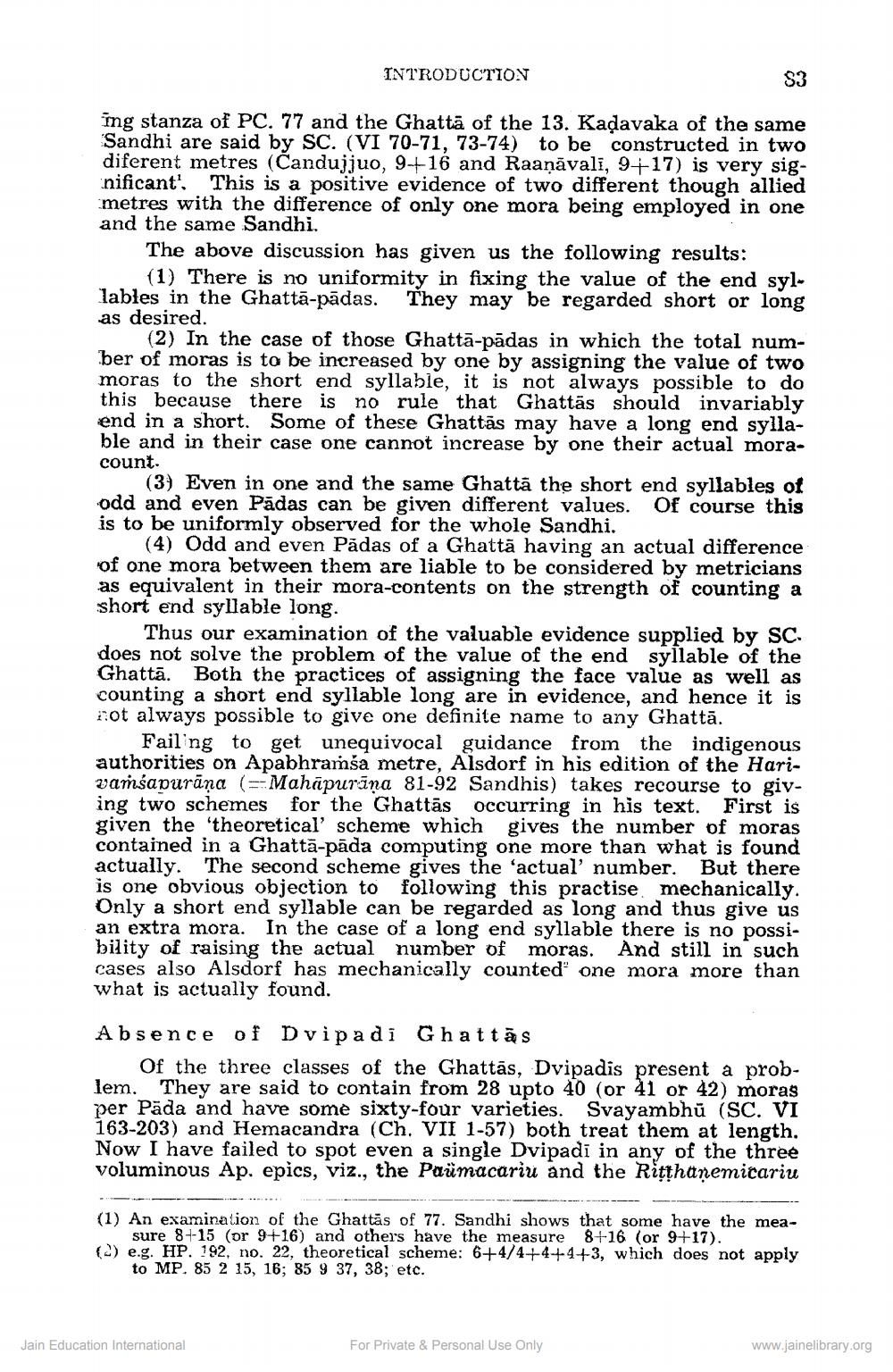________________
INTRODUCTION
S3
odd and ewiformly obserädas of a ble to be contrength of
to (4) Odd and even them are liable ton the strengti
ing stanza of PC. 77 and the Ghatta of the 13. Kadavaka of the same Sandhi are said by SC. (VI 70-71, 73-74) to be constructed in two diferent metres (Candujjuo, 9+16 and Raaņāvali, 9+17) is very significant' This is a positive evidence of two different though allied metres with the difference of only one mora being employed in one and the same Sandhi.
The above discussion has given us the following results:
(1) There is no uniformity in fixing the value of the end syllables in the Ghattā-pādas. They may be regarded short or long as desired.
(2) In the case of those Ghattā-pādas in which the total number of moras is to be increased by one by assigning the value of two moras to the short end syllable, it is not always possible to do this because there is no rule that Ghattās should invariably end in a short. Some of these Ghattās may have a long end syllable and in their case one cannot increase by one their actual mora. count.
(3) Even in one and the same Ghattā the short end syllables of odd and even Pädas can be given different values. Of course this is to be uniformly observed for the whole Sandhi.
(4) Odd and even Pădas of a Ghattä having an actual difference of one mora between them are liable to be considered by metricians as equivalent in their mora-contents on the strength of counting a short end syllable long.
Thus our examination of the valuable evidence supplied by SC. does not solve the problem of the value of the end syllable of the Ghattā. Both the practices of assigning the face value as well as counting a short end syllable long are in evidence, and hence it is not always possible to give one definite name to any Ghattā.
Failing to get unequivocal guidance from the indigenous authorities on Apabhraíša metre, Alsdorf in his edition of the Harivamśapurāņa (=-Mahāpurāņa 81-92 Sandhis) takes recourse to giving two schemes for the Ghattās occurring in his text. First is given the 'theoretical' scheme which gives the number of moras contained in a Ghattā-pāda computing one more than what is found actually. The second scheme gives the 'actual' number. But there is one obvious objection to following this practise mechanically. Only a short end syllable can be regarded as long and thus give us an extra mora. In the case of a long end syllable there is no possibility of raising the actual number of moras. And still in such cases also Alsdorf has mechanically counted" one mora more than what is actually found.
es of the chose up to 10 svay anem a lettere
Absence of Dvipadi Ghattas
Of the three classes of the Ghattās, Dvipadis present a problem. They are said to contain from 28 upto 40 (or 41 or 42) moras per Päda and have some sixty-four varieties. Svayambhū (SC. VI 163-203) and Hemacandra (Ch. VII 1-57) both treat them at length, Now I have failed to spot even a single Dvipadi in any of the three voluminous Ap. epics, viz., the Paümacariu and the Righanemicariu
(1) An examination of the Ghattās of 77. Sandhi shows that some have the mea
sure 8+15 (or 9+16) and others have the measure 8+16 (or 9+17). (-) e.g. HP. 192, no. 22, theoretical scheme: 6+4/4+4+4+3, which does not apply
to MP. 85 2 15, 16; 85 9 37, 38; etc.
Jain Education International
For Private & Personal Use Only
www.jainelibrary.org




